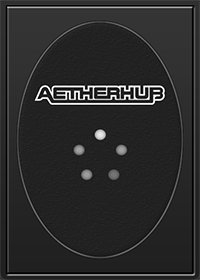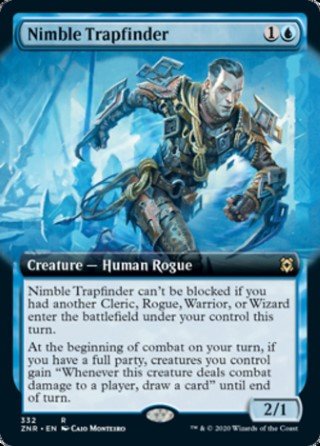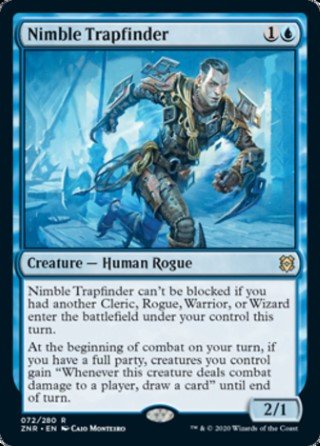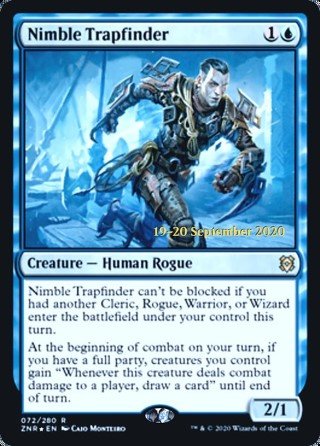
Nimble Trapfinder
Creature — Human Rogue
Nimble Trapfinder can't be blocked if you had another Cleric, Rogue, Warrior, or Wizard enter the battlefield under your control this turn.
At the beginning of combat on your turn, if you have a full party, creatures you control gain "Whenever this creature deals combat damage to a player, draw a card" until end of turn.
|
Zendikar Rising Promos (PZNR)
#72p, Rare |
Illustrated by: Caio Monteiro
Not Legal Alchemy BO1
Not Legal Standard BO1
Not Legal Brawl
Not Legal Pauper
Not Legal Traditional Standard
Not Legal Traditional Alchemy
Rulings
- 2020-09-25
An ability referring to the number of creatures in your party gets a number from zero to four. Such abilities never ask which creatures are in your party, and you never have to designate specific creatures as being in your party. You can’t choose to exclude creatures from this count to lower the number. - 2020-09-25
Nimble Trapfinder’s first ability checks only whether a permanent entered the battlefield under your control earlier in the turn and had one of the party creature types as it entered. It doesn’t apply if an entering object gained the type later in the turn. It does apply if the entering object left your control since. It doesn’t matter whether Nimble Trapfinder was under your control as that object entered. - 2020-09-25
Nimble Trapfinder’s second ability affects only creatures you control at the time it resolves. Creatures you begin to control later in the turn won’t get the triggered ability. - 2020-09-25
After Nimble Trapfinder’s second ability has resolved, creatures you control keep the triggered ability for the turn even if you no longer have a full party later in the turn. - 2020-09-25
To determine “the number of creatures in your party,” check whether you control a Cleric, whether you control a Rogue, whether you control a Warrior, and whether you control a Wizard. The number is the total number of those checks to which you answered yes. Each creature you control can be counted for only one of those checks. - 2020-09-25
If a creature has more than one party creature type, and there are multiple ways to count that creature that could result in a different number of creatures in your party, the highest such number is used. For example, if you control a Cleric and a Cleric Wizard, the number of creatures in your party is two. You can’t choose to have it be just one by counting the Cleric Wizard first as a Cleric. - 2020-09-25
Some cards refer to you having a “full party.” This is true if the number of creatures in your party is four.
| PRINTS | USD | EUR | Tix | |
|---|---|---|---|---|
|
|
$0.41 | |||
|
|
$0.25 | €0.10 | 0.02 | |
|
|
||||
|
|




